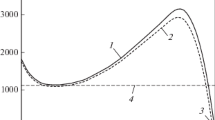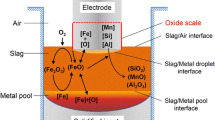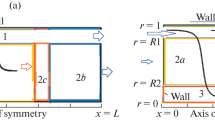Abstract
Numerical solutions of the oxygen-diffusion problem arising in the oxidation of metals at high temperatures are complicated by the change in density as the oxide is formed and the occurrence of moving boundaries separating the different phases. The former complication is resolved by a transformation of the dependent variable and the coordinate, which reduces the problem to a form identical to one without density change. The latter complication is dealt with by demonstrating an analogy with the Stefan problem in heat transfer with phase change in the enthalpy formulation, for which abundant numerical works exist. A finite-difference code is written to solve the resulting equations. It is successfully applied to simulate an oxidation experiment of Zircaloy by steam at 1600°C.
Similar content being viewed by others
References
C. Wagner,Corros. Sci. 9, 91 (1969).
D. E. Coates and A. D. Dalvi,Oxid. Met. 2, 331 (1970).
J. A. Nesbitt,Oxid. Met. 44, 309 (1995.
R. E. Pawel,J. Nucl. Mat. 49, 281 (1973).
M. Suzuki and S. Kawasaki,J. Nucl. Sci. and Tech. 17, 291 (1980).
F. C. Iglesia, D. B. Duncan, S. Sagat, and H. E. Sills,J. Nucl. Mat. 130, 36 (1985).
P. Hofmann and H. J. Neitzel, inSeventh International Conference on Zirconium in the Nuclear Industry (Strasbourg, France, June 24–27, 1985).
J. A. Nesbitt and R. W. Heckel,Thin Solid Films 119, 281 (1984).
E. Y. Lee, D. M. Chartier, R. R. Biederman, and R. D. Sisson Jr.,Surf. Coat. Technol. 32, 19 (1987).
J. A. Nesbitt,J. Electrochem. Soc. 136, 1518 (1989).
J. A. Nesbitt and E. J. Vinarck, inDamage and Oxidation Protection in High Temperature Composites, G. K. Haritos and O. O. Ochoa, eds., AD-Vol. 25-1 (ASME, 1991), p. 9.
D. Murray and F. Landis,J. Heat Transfer 81, 106 (1959).
J. Crank,Mathematics of Diffusion, 2nd edition (Oxford University Press, Oxford, 1975).
V. R. Voller,Numer. Heat Transfer B 17, 155 (1990).
M. Moalem and D. R. Olander,J. Nucl. Mat. 182, 170 (1991).
R. E. Pawel,J. Electrochem. Soc. 126, 1111 (1979.
D. R. Olander,J. Electrochem. Soc. 131, 2161 (1984).
L. Baker and L. C. Just,Studies of Metal-Water Reactions at High Temperatures (Argonne National Laboratory Report ANL-6548, 1962).
V. E. Urbanic and T. R. Heidrick,J. Nucl. Mat. 75, 251 (1978).
R. E. Pawel, J. V. Cathcart, and J. J. Campbell,J. Nucl. Mat. 82, 129 (1979).
T. Furuta and S. Kawasaki,J. Nucl. Mat. 105, 158 (1982).
J. T. Prater and E. L. Courtright, inProc. 7th Int. Symp. on Zirconium in the Nuclear Industry (ASTM-STP 939, 489 (1987).
Author information
Authors and Affiliations
Rights and permissions
About this article
Cite this article
Wong, S.K., Chan, C.C. & Crusher Wong, S.K. An improved formulation of the oxygen-diffusion problem and its application to Zircaloy oxidation by steam. Oxid Met 47, 427–444 (1997). https://doi.org/10.1007/BF02134785
Received:
Revised:
Issue Date:
DOI: https://doi.org/10.1007/BF02134785




